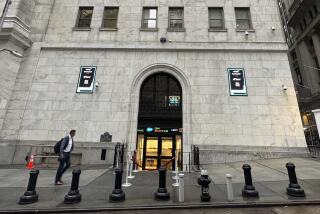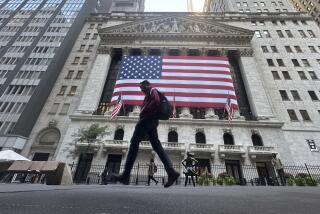Wall Street Asks How High Is Too High for Stocks
Like a rich but crazy relative, the U.S. stock market is something that people aren’t quite sure how to talk about these days.
On one hand, it seems wrong to speak ill of it, because so many Americans are hoping to eventually cash in on its largess.
On the other hand, the market’s actions seem so outlandish--as it continually scales new heights--as to be bordering on frightening, making it difficult to just look askance.
The Dow Jones industrial average’s hurdling of the 7,000 mark last week was another reminder of how spectacular this 6-year-old bull market has been, and how its intensity appears to be building rather than ebbing.
But with each new high in the Dow, Wall Street has become preoccupied with a debate that is at once esoteric and yet enormously consequential for millions of small investors: Have stock prices reached absurd levels that could invite a ruinous, long-lasting decline? Or is there something fundamentally different about the economy today, and the market, that makes stocks inherently more valuable than at any time in history?
The questions are more than academic, of course, because the burgeoning popularity of automatic retirement investment programs, such as corporate 401(k) plans, means that the future financial health of many American families depends more than ever before on what happens to stock prices over time.
Yet, that aspect of the 1990s bull market also adds an ironic twist to the “how-high-is-too-high-for-stocks” debate: Many Wall Street pros who believe that share prices are reaching excessive levels blame the very public that is being constantly exhorted to save and invest more and not worry about the market’s short-term trends.
Certainly, the short-term trend has become tough to ignore. Of the nearly 200% rise in the Dow since the current climb began in October, 1990, nearly half of the advance has occurred just in the last two years. Already this year, the index is up 8.5%, closing Friday at 6,988.96, off slightly from its record of 7,022.44 set on Thursday.
By one key measure, the market value of U.S. stocks now stands at $7.7 trillion, which means U.S. shareholders have seen their stock wealth balloon by $1.6 trillion in the last year alone.
Wall Street professionals and most individual investors alike can recite the litany of good reasons for stocks’ stunning 1990s advance, now the longest-ever bull market: the global rise of capitalism; freer trade; declining government budget deficits; surging corporate earnings; rising investment by aging baby boomers; and, most important, a plunge in inflation worldwide, which has allowed interest rates to remain relatively benign.
“I can’t remember, in all of the years I’ve been in this business, a more favorable combination of background forces for stocks,” said Bradlee Perry, the 70-year-old former chairman of the Babson Group of mutual funds in Boston.
Yet even the stock market is supposed to be bound by certain limits. Historically, prices of individual shares have been restricted by three factors: underlying corporate earnings, expected future earnings growth and market interest rates.
By many accounts, U.S. share prices now are pushing the envelope in terms of their levels relative to those factors. That, in turn, has fueled the idea that the new generation of American investors, most of whom have only owned stocks or stock mutual funds in this decade, are consciously or subconsciously setting higher “fair” levels for share prices than previous generations.
The implication is that investors are jettisoning old rules that Wall Street has long viewed as gospel. To some veteran market analysts, such talk of a “new era” for stocks smacks of the worst investment heresy, and is the clearest evidence that the market has reached a mania stage that will give way to a horrendous fall in share prices.
“In any market, the risk is greatest when everything looks safest,” and when investors declare that old rules don’t apply anymore, said David Tice, a Dallas-based money manager who is extremely bearish on stocks.
The soaring price of Coca-Cola Co. shares, one of the 30 blue-chip stocks in the Dow index, perhaps best illustrates the sacking of many old Wall Street paradigms. At $60.63 as of Friday, a record high, Coke’s stock sells for 43 times the $1.40 per share that the company actually generated in earnings for stockholders last year.
Over the last 17 years, Coke’s stock price-to-earnings ratio, or P/E as it is called in market lingo, has averaged about 19. So investors today are willing to pay far more for $1 worth of Coke’s earnings than they have in the recent past.
The danger in paying an ever higher P/E ratio for a stock is that, as a shareholder, there is less of something substantive backing up your investment. Even if Coke’s earnings continue to grow--and they are expected to rise between 15% and 20% this year--the higher the share price you pay relative to those earnings, the greater the potential decline in the stock should investors suddenly sour on Coke, for whatever reason.
The issue is not whether Coca-Cola is a solid company, but how much a rational investor should pay to own it. Or, as Babson Funds’ Perry puts it, “While these [blue chip] companies may be safe, their stocks aren’t necessarily safe” at these levels.
The surge in prices, and price-to-earnings ratios, of blue-chip stocks in particular over the past year has prompted comparisons with the red-hot market of 1972. That was the era of the “Nifty Fifty,” a relative handful of well-known stocks that became the “must-own” stocks of their generation--and which came to sell for P/Es of 50, 60 or more.
That list included McDonald’s, Avon Products, Xerox Corp. and Polaroid.
But the Nifty Fifty era ended in disaster, with the Dow index plunging 45% between January 1973 and December 1974, amid the first Arab oil embargo, soaring inflation, a deep recession and the scandal-forced resignation of President Richard Nixon.
Jeffrey Applegate, chief investment strategist at brokerage Lehman Bros. in New York, concedes that the rising P/E ratios of big-name stocks today are “terrifying” many investors who have even a rudimentary knowledge of market history.
Yet, Applegate and other analysts pointed out that many smaller stocks are lagging the blue-chip issues in performance, suggesting a much more normal stock market overall.
And notwithstanding a select few high flyers such as Coke, the average P/E multiple of blue chip stocks, as measured by the Standard & Poor’s 500 index of major U.S. shares, currently stands at about 20 based on 1996 earnings per share, Applegate said.
That is only slightly above the 18-to-19 peak P/E range that the S&P; index maintained from 1959 to 1966--the last period in U.S. history similar to the 1990s, with low inflation, decent economic growth, an ascendant American industrial base and tame interest rates, Applegate noted.
It’s hardly a coincidence, he said, that leading stocks are valued as highly today as they were then. “All of these things have put the stock market in a real sweet spot,” he said.
Moreover, bullish analysts can make a case that investors are justified in thinking that stocks are worth even more today than they were in the early 1960s, because companies’ potential may be vastly greater--thanks to the end of the Cold War and the global embrace of free enterprise.
And while most market pros agree that U.S. companies’ earnings growth overall will slow to the 5% to 10% range this year--after three years of double-digit gains powered in part by the corporate restructuring wave--the bulls say that is a prescription for a slower-moving stock market, but not a lower one.
Philip Orlando, investment strategist at Value Line Asset Management in New York, believes the Dow can reach 7,650 in 1998 even as earnings growth slows, because he expects interest rates to fall as global economic growth remains moderate and inflation stays tame.
A key element in his outlook, he said, “is that we’re going to get a balanced-budget deal in Washington,” which could further encourage investors because it would imply that more capital would be available to finance the expanding private sector of the economy.
A basic assumption underlying all the optimistic forecasts for stocks is that the U.S. and global economies will continue to grow in the years ahead, since the alternative to that--stagnation or recession--would almost surely make stocks less appealing to investors.
And it is the economy’s seemingly robust health that perhaps most emboldens Wall Street to believe prices, while historically expensive, can become more so.
Last year saw the biggest rise in average worker wages since 1990. Yet corporate profits also were up strongly, while inflation remained subdued. For all three of those trends to occur at the same time suggests an economy that is extremely well balanced and amazingly productive, experts say.
To critics who say that long-standing ideas about stock values shouldn’t be revised in such an environment, bullish investment strategist Abby J. Cohen at Goldman, Sachs & Co. in New York quotes economist John Maynard Keynes: “When the facts change, I change my mind. What do you do?”
When Federal Reserve Board Chairman Alan Greenspan, in early December, uttered his now-famous line about “irrational exuberance” in financial markets, he implied that the Fed was engaged in the same debate over the market’s “fair” value: Greenspan was posing a question, wondering aloud what constitutes excessive optimism in the stock market when the economy is performing as well as this one.
For the relative handful of bearish analysts still left on Wall Street, there is no debate. They say U.S. stocks are grossly overvalued by virtually every yardstick. Sooner or later, they add, something will happen to throw the world economy off balance again, like the oil shocks of 1973 and 1979 or the Iraqi invasion of Kuwait in 1990. Investors then will become far less enamored of stocks--and the higher prices get, the deeper they will plunge.
James Grant, publisher of Grant’s Interest Rate Observer newsletter in New York and a long-time bear, believes the most dangerous aspect of stocks’ continued advance is that it is being fueled, in his view, by people engaged in “the act of investing” for its own sake: They are buying not because their research shows the market has value, but simply because it is going up.
That is another way of saying that the stock market is in the throes of a mania, says money manager David Tice. “And when you get into the mania stage it can go on for a long time,” he concedes. But every mania eventually ends, he notes, when the desire to make money suddenly is overwhelmed by fear of losing it.
“What we know from history is that markets tend to penalize people who have too much greed and not enough fear,” Tice said.
More to Read
Inside the business of entertainment
The Wide Shot brings you news, analysis and insights on everything from streaming wars to production — and what it all means for the future.
You may occasionally receive promotional content from the Los Angeles Times.










